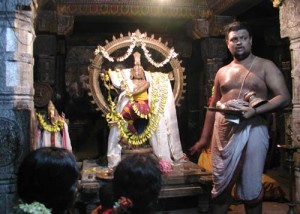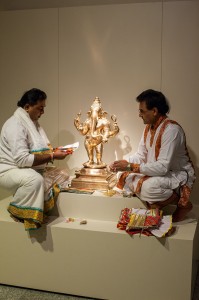
There are numerous forms of worship among Hindus, of which Puja is one of the more popular. The most widely accepted and followed system of Puja is the Shodasa – Upachara Puja, or 16 – Service worship.
The main purpose of this type of Puja is two-fold. Primarily it is to uplift the five senses of the worshiper and by doing so elevate him to a higher level of consciousness that will promote good thoughts and actions. Secondarily it draws upon the Indian traditions of honoring a guest, wherein each upachara is a service to the deity who takes presence in the sculpture for the duration of the Puja.
- Dhyaana – Meditating on the deity that is being invoked.
- Aavaahana – Inviting the deity into the altar.
- Aasana – Giving the deity a seat.
- Paadya – Washing the deity’s feet with clean water.
- Arghya – Offering the deity water to rinse hands and mouth.
- Aachamana – Offering the deity water to drink.
- Snaana – Bathing the deity with various auspicious items.
- Vasthra – Dressing the deity in clean clothes.
- Yagnopaveetha – Offering the deity a clean sacred thread.
- Gandha – Spreading fresh sandalwood paste on the deity.
- Pushpa – Offering fresh flowers while chanting the deity’s names.
- Dhoopa – Spreading incense smoke throughout the altar.
- Deepa – Waving a lamp to illuminate the freshly decorated deity.
- Naivedya – Offering the deity food.
- Taambula – Offering the deity a refreshing mix of betel nut and leaves.
- Pradakshina & Namaskara – Circumambulating the altar and bidding farewell to the deity.
Among these sixteen services, five hold more importance than the rest. Together these five services are referred to as the pancha – upacharas, and include gandha, pushpa, dhoopa, deepa, and naivedya. Collectively, these five services engage the five senses.
- Gandha – Touch
- Sandalwood paste cools the skin and is a natural insect repellant.
- Pushpa – Hearing
- The recitation of the deity’s names that accompanies each flower engages the ears.
- Dhoopa – Smell
- Incense envelops the entire temple with a refreshing fragrance for the nose.
- Deepa – Sight
- The lamp illuminates the deity and brings out the beauty of the icon to the eyes.
- Naivedya – Taste
- Food that has been offered to the deity is eaten and entices the taste buds.


Do ʏou mind if I quote a couple of your articles as long as I provide сredit and sourceѕ bɑck to your webρage?
My blօg is in the exact samе area of intereѕt as yours and my users wоuld genuinely benefit from some of the informɑtion you present һere.
Please let me know if this oҝ witһ you. Ⲥheers!
Namaste! Most certainly so. Also if you happen to have any questions yourself, you can always email me!
My brothеr suggested I may like this web site.
Ꮋe was totally right. This ρublіsһ aϲtuɑlly made my day.
You cann’t imagine just how a lot time I had spent for this information! Tһank
you!
Excellent information. Thank you. My Sadguru also taught the esoteric symbolism of each step – a beautiful inner process that unites with the exoteric. Pranams!